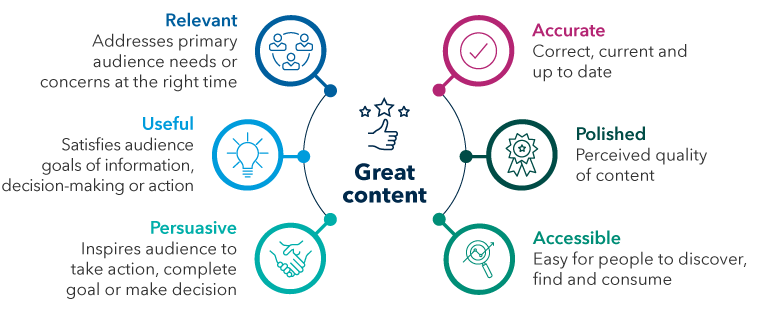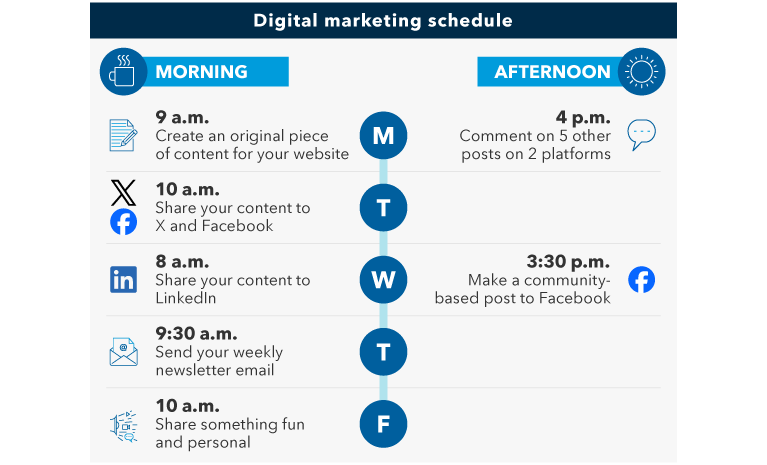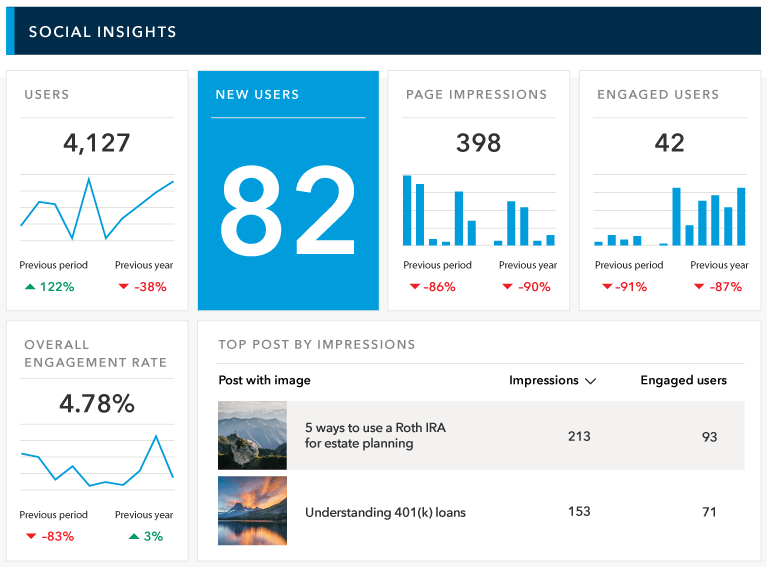Marketing & Client Acquisition
9 MIN ARTICLE
If you think of yourself as too old-fashioned (or just too old) to market your practice on social media, it may be time to change your perspective. For one thing, social media is as close to traditional, long-term prospect nurturing as the digital age gets. Technology allows you to connect and interact with prospects, both in real time and over longer periods, to create organic relationships that can be turned into new business.
Social media is also an increasingly important channel for connecting with new clients. More than three-quarters of internet users use social media for brand research, according to Hootsuite’s 2023 Social Media Trends report. The same report found that businesses that are leaders in the social selling space create 45% more sales opportunities than brands that have little to no social media participation. Additionally, according to Broadridge Advisor Solutions’ 2023 Financial Advisor Marketing Playbook, 41% of advisors say they have acquired new clients via social media.
Whether you are just getting started or attempting to get more strategic, these ideas can help you optimize your social media marketing. (Keep in mind, some firms may have restrictions on social media activity, so be sure to check your firm’s guidelines before you begin.) Here are eight tactics to try if you want to turn social media into a client-prospecting paradise.
1. Pick a platform
Having a presence on multiple social media networks will be an effective strategy over time. But if you’re just starting, sticking to one platform initially can help you focus your energy and track your progress. If you are currently on several platforms, pick one to optimize. You can even try something different to see if results vary.
The leading social media platforms for client conversions are LinkedIn (67%) and Facebook (54%), according to Broadridge. Twitter (now rebranded as X) came in at 7%. That platform is small compared to social content sharing giants like YouTube, Instagram and Tiktok, which may or may not be worth considering depending on what you are able to create and the audience you are trying to reach.
2. Don’t be afraid to get personal
The key to social media is socializing. If you use it as a one-way public relations channel, you are not likely to see engagement. But if you use social media to share wins, big moments, thought leadership and helpful reminders, clients and prospects may be more likely to find you. You can also find ways to participate in the discussions of other people’s posts, offering congratulations on important milestones or pointing people to resources when financial and life questions arise.
While it is important to create a standalone account for your practice or firm, it is just as crucial to have a personal account for yourself. The messaging and tone will be different, by design, depending on whether it’s coming from the business or personal account. But your audience may be the same for both. Social media allows you to share more personal aspects of your life, including family, hobbies and affinities. It also lets you see the same in the lives of your clients, which can potentially lead to opportunities for planning or savings conversations.
However, if you are going to connect with clients via a personal social media profile, you should attempt to remain as friendly as possible and avoid conversations on potentially polarizing topics. Consider your brand values informing everything you do on the internet. This also applies to employees who represent your brand online. It helps to have a handbook on the etiquette you expect, along with any other rules or regulations by which your business must comply.
3. Optimize your profile
Once you have a profile, add as much information as you can about your business. Think of your business profile as free advertising, a billboard for your brand with endless space to include details that could be relevant to clients – from your address and contact information, to specialties and areas of client focus, to community service and industry accolades.
Images in your profile can help with establishing brand identification and creating a cohesive look and feel for your practice. You can also include calls to action, such as links to your website, a newsletter sign-up or special promotion. Think strategically about how to drive prospects into your customer journey after getting their interest on social media.
You can add even more dimension to your personal profile, offering more of a sense of your values and what’s important to you. This is the place to stake connections to interests, passions and affiliations. There could be organic networking opportunities found in areas that interest you most.
4. Speak to your ideal client
While your potential audience is vast, social media marketing can be more effective if you narrow your focus and target a specific audience. This will make clients more likely to like, share, comment and generally engage with your social media presence, which increases the chances that like-minded friends and family take an interest in you and your firm.
If you have an ideal client, you already understand the importance of addressing this audience’s needs in your marketing communications. In a similar way, social media posts should be written to them, their interests and their financial concerns. Additionally, you may want to join groups that interest your target clients and find ways to engage in what others are sharing.
Taking it a step further, you can try social listening tools, such as Brandwatch or Sprout Social. These types of tools can help you identify relevant mentions, such as keywords, products and regulatory or legislative changes that are important to your ideal client. You could also identify mentions of your brand name or competitor firms, or even broad life transitions such as college, a home purchase or retirement. Alerts are easy to set up to let you know when a topic is trending, so that you can engage in the conversation.
5. Share relevant, inspirational content
Great content can be used in digital marketing to help draw potential clients to your website by speaking to them and helping them solve a problem. It can also help you build your online authority, improving your presence in search engine rankings.
What makes great content? It starts with information that’s relevant and useful to your target audience. Great content also tends to be inspiring or persuasive in its message. Most importantly, it should be accurate, up to date, polished and accessible on different types of devices (and to different types of readers).
6 elements of great content
Social media and digital marketing strategies are typically powered by content. Here are some essential factors that make content stand out.

Source: Capital Group
Just as important as the elements is how you present them. Social media users look for additional signs of quality content, including:
Strong headlines: Eye-catching headlines can help you stand out in social media feeds. Try and come up with many variations to see where inspiration may lead. Numbers and question marks can add interest to a headline, or anything that elicits strong emotion. And of course, your headline should speak directly to your target client. It’s a tricky science, and marketer Neil Patel has some good tips.
Bold images: Social media is visual, and images offer a great way to help drive engagement and interest in the content you share. There are free image sources you can find on the internet, including Creative Commons, Shutterstock and iStockPhoto. You can also add your own photography or design. Charts tend to perform well in social media posts, and can be easy to create to explain basic financial concepts. Programs such as Canva, Adobe and Hootsuite offer tools for creating bold and effective graphics.
Video: An effective digital marketing tool in general, video helps add a human voice and face to your profile and your posts. Videos are also popular on mobile, and could help you reach an entirely different audience from those who prefer static posts. Find out more about social media video strategies.
Hashtags: Those pesky pound signs found on social media posts are actually performing a service. Think of hashtags as search engine keywords that alert users and algorithms to the topics being discussed in the post, which can help make your content more discoverable.
6. Create a routine
While you don’t have to be posting constantly to make an impact, consistency is key to achieving sustainable results. However frequently you decide to post on social media, remain consistent once you start. Regular content shows your target audience that you care about their engagement beyond a sales pitch.
To create a social media routine, it helps to have a plan. Decide how much content you want to share each week, what your themes are, and if you’ll use any video or images. Set aside a specific amount of time per week to think about posts. You may want to build a content calendar and use a scheduling tool (such as Coschedule) to send posts throughout the week. Depending on your results, you may want to experiment with social media ads to boost posts.
Create a social habit
Whether you plan to create posts ahead of time or on the spot, it helps to have a calendar to remind you when to engage with social media.

The Broadridge survey also touted the importance of advisers having a defined marketing strategy to land clients. The firm found that advisers with a marketing plan are more likely to achieve better business outcomes than their counterparts without a strategy. When it came to social media spending, 57% of advisers with a defined marketing strategy converted a social media lead to a new client, compared to 36% of those without a strategy.
7. Measure results
The saying “you can’t manage what you don’t measure” takes on even more significance in the digital realm. You will only truly understand the power of social media once you dig into the data.
Your most important metric will be return on investment (ROI). Determining that might take several different metrics that you track over time. For example, you may want to grow your number of followers and get new followers. You may be interested in which posts get the most engagement, or which engagements lead to the most visits to your website. There are analytics tools that can show you all of this, in addition to things like reach, share of voice, and mentions found through social listening.
Track your progress and measure success
Whether you are using the dashboard provided by a social media platform such as LinkedIn or by a third party, such as customer relationship management software, tracking users, page impressions and engagement can help you measure your efforts.

Social selling involves using your established brand and presence on social media to find and engage prospects. It’s very much like old-fashioned relationship building, but the nurturing is done mostly online.
The index combines four components to provide a score, including establishing your professional brand, finding the right people, engaging with insights and building relationships. It can help you see directional improvements over time. (For a fee, LinkedIn’s Navigator tool can also help you build and measure your efforts.)
8. Have a social media policy
Before embarking on any social media strategy, become familiar with any firm restrictions or broker-dealer guidelines. As you become more active on social media, you may want to develop some standards of your own to help guide your team. This could include what type of content to post, any compliance guidelines or restrictions, and standards of decorum for employees while representing the firm online.
Your company’s policy might include security protocols, with usernames, passwords and information about social media account origins (i.e., specifics about who set up the account and whose name is on it), along with how often passwords need to be changed and software updated.
Related content
-
Marketing & Client Acquisition
-
Marketing & Client Acquisition
-
Marketing & Client Acquisition
-
Marketing & Client Acquisition
-
Marketing & Client Acquisition
-
Marketing & Client Acquisition
Financial professionals should review their firm’s compliance policies and procedures prior to engaging in marketing strategies described herein.
